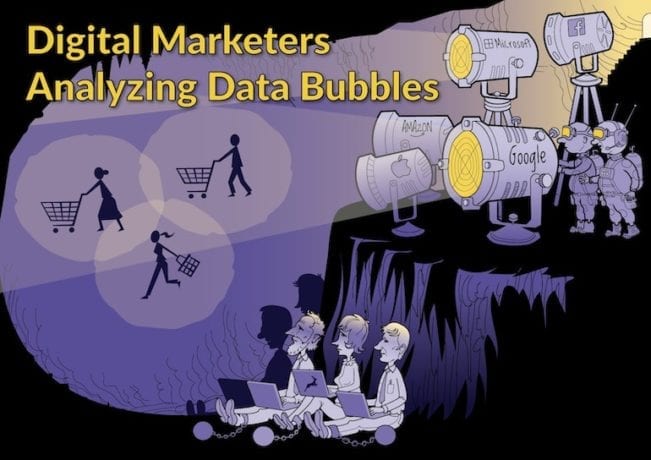
Wow, there is so
much you can learn from the data. So much you can do with digital marketing. We
can track 70% of the user journey, can’t we? This is the average, indicated by
leading digital marketers in our survey. But what about un-trackable offline
actions? What about the data lost through privacy protection and ad blocking? And finally, what about data that is incompatible
across platforms? With all these “what ifs”, is what we are seeing on the basis
of partial data a fair representation of reality?
Rewind to 2011,
and SEOs were outraged over Google’s removal of referrer data from search
results, effectively removing one of the most precious pieces of information
SEOs had to hand: real keyword queries. This was, of course, for security
reasons; the SEO community got over it, and “not provided” lives on.
This also reminds
me of 2020 when paid search marketers became outraged over Google’s removal of “insignificant
searches” from search-term reports and reporting a 30% reduction in the
reported volume of search terms. More precious data is disappearing – to
protect user privacy, of course. Oh well, the paid search community will get
over it, and there is still a lot of data available.
Plato’s cave
The Greek
philosopher Plato wrote the allegory of the cave around 400 BC. It describes a
group of people chained up in a cave looking at a blank wall onto which shadows
are projected from activity behind their backs. What they see as reality is a
partial and distorted view of real activity. In order to unchain themselves and
find reality, they need to be educated in things like mathematics and deductive
logic.

Plato’s allegory was
an inspiration for the popular film The Matrix, a more modern
representation of people being manipulated into seeing a false and comforting
reality.
Digital marketers
are not in The Matrix; they are sitting in Plato’s cave, and Google,
Facebook and Amazon are showing them what Socrates would call a “superficial
truth”, shadows cast on a wall from those companies’ torchlight projections on
to real actions by end users.
Data bubbles
Digital
marketing platforms like Google, Facebook, Amazon, Apple and Microsoft
aggregate enormous amounts of data on user behaviour and characteristics.
Digital marketers are well aware that those data sets don’t communicate. And,
in reality, perhaps the real value proposition for any digital marketing agency
is to be a data arbiter and data-flow facilitator between data sets. As seen
above, Google seems to be on a path to reducing access to its data. Facebook
and other social media platforms have never given you access to any raw data
and will provide you with the data they believe will best help you fulfil their
purpose. Independent tracking and raw data is “not provided”.
Each platform
is building its own gigantic data bubble, trying to show its own version of
reality to digital marketers and advertisers. It can feel magical when you see
the illusion of a complete truth. Artificial intelligence is correcting and
projecting the data to create a compelling story. You can try this on yourself
by checking out your personal profile on adssettings.google.com and facebook.com/ads/preferences.
Personally, I would like to say “thanks but no thanks” to country music, cats
and coupons! They are some of my interests, according to Google’s interface. They
are actually totally the opposite of what I like, and I’m not sure how the AI
came up with them. Yet so much of the information is true or surprisingly
close.
Data realism
I am always
impressed and a little scared when I see digital marketers with complete faith
in data, building strategies on surprising insights they found in the data
sets. It is important to take a step back and remember that digital marketers
are always working on partial data sets. Always. Data is NOT fact.
In our research for the recent report “Digital Marketing in a VUCA World”, we noticed something else. Leading digital marketers have taken a hit of -40% in media spend among their clients, and they also had to recalibrate algorithms as a consequence of changing user behavior. Smart Bidding can’t be smart if the data changes. According to the survey, they altered around 20% of campaigns in the light of behavioral changes. This is a great example of data realism, where digital marketers are raising their heads and looking at the bigger picture.
In the near
future, data sets will be changing even more due to external factors such as more
privacy regulation, the end of cookies and permanent changes in user behaviour.
Data realism will be even more important when the world goes VUCA (volatile,
uncertain, complex and ambiguous).
Emerge from the cave
We were
concerned to see that the role of data analysts in our survey group was less
important than a few years back, perhaps because their short-term value is
difficult to justify. As Smart Bidding has seen an enormous uptake over the
same period, there is a risk that digital marketers will become more dependent
on data bubbles and AI.
To counter
these effects, we suggest a number of directions digital marketers can take.
Here are a couple of them:
Decipher black boxes:
Are black boxes really so black that nothing can be extracted? Analyzing and comparing outcomes from automated processes seems more important than ever.
Build proprietary data:
End-user data and its interpretation is becoming valuable. When using a platform to sell one’s product, the value of data can be considered part of the decision-making process, and efforts to reclaim data can be systematically undertaken.
Emerging from
the cave is about increasing one’s digital maturity. Becoming a data realist
and being aware of partial data sets is already a big step. Bridging data flows
between platforms is another, and if digital marketers can become the arbiters
of how the projections on the wall should be interpreted, they have come a long
way.

Leave a Reply